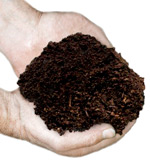Maintain Soil Health
One important concept to remember about keeping soil healthy is that we need to put back what we take out of our soil.
This means leaving the leaves, twigs, etc. from a tree to mulch the area under the tree. This way, the nutrients that the tree took from the soil are returned and this keeps the soil nutrients balanced.
The same applies in vegetable or fruit gardens. When the tomato vines die at the end of the year, the stem is broken from the roots and the roots are left in the soil to feed the microorganisms that which was taken from the soil to grow the tomato. The dried upper plant parts can be broken up and used for mulch on this bed along with other mulch. If diseased, add them to the compost pile.
This process keeps the soil healthy and alive with active microorganisms; as bacteria, fungi, protozoa, nematodes and more - all part of the Soil Food Web.
Some people grow what is called a cover crop (also called green mulch) on a bed when it is not being used to grow food. Cover crops can put back many nutrients which may have been depleted from "heavy eater" crops.
"Gardener's gold" or commonly called compost, is the most perfect support for keeping your Soil Food Web community and microorganisms alive and healthy.
This is a community of millions of diverse organisms all doing their job making healthy soil/humus.
Our job is to keep the organisms supplied with raw food and to keep them alive and well in our soil.
The underlying principle is that good soil contains copious amounts of organic matter to feed the soil organisms which, in turn, excrete the nutrients that plants need, in a form that plant roots can take up.
All these organisms eat organic matter or consume other organisms. As they digest this material, nutrients are converted from one form to another (in the same way that the food we eat is changed by our digestive enzymes). The organisms retain what they need for their own growth and reproduction; what they excrete contains nutrients now in a form that plant roots can take up.
Besides opening up and softening the soil, organic matter is essential to form a sponge in the soil which will trap water from rain or irrigation and prevent it from quickly percolating down out of reach. At the same time it retains any soluble food materials which are being carried down by the water.
THINGS TO AVOID
Chemical fertilizers negatively impact the Soil Food Web by killing off entire portions of it. Note what table salt does to a slug. Fertilizers are salts; they suck the water out of the bacteria, fungi, protozoa and nematodes in the soil. Since these microbes are at the very foundation of the Soil Food Web nutrient system, you have to keep adding fertilizer once you start using it regularly. The microorganisms are missing and not there to do their job of feeding the plants.
Once the microorganisms die, the other members of the Soil Food Web will leave to. For example, earthworms, will leave when they lack food and are irritated by the synthetic nitrates in soluble nitrogen fertilizers. All of this impacts the nutrition, as well as the structure of the soil. Watering becomes a problem because the sponge has broken down and pests and diseases are able to establish themselves. Gardening like this is a lot of work and nutrition is depleted from fruits and vegetables.
If the salt-based chemical fertilizers don’t kill the organisms, then rototilling will. This process breaks up fungal hyphae, kills worms, and rips and crushes arthropods. It destroys soil structure/soil sponge and eventually saps soil of necessary air. Air pollution, pesticides, fungicides and herbicides also kill off important members of the Soil Food Web community or cause them to find a better place to live. The soil stops functioning.
![]()
